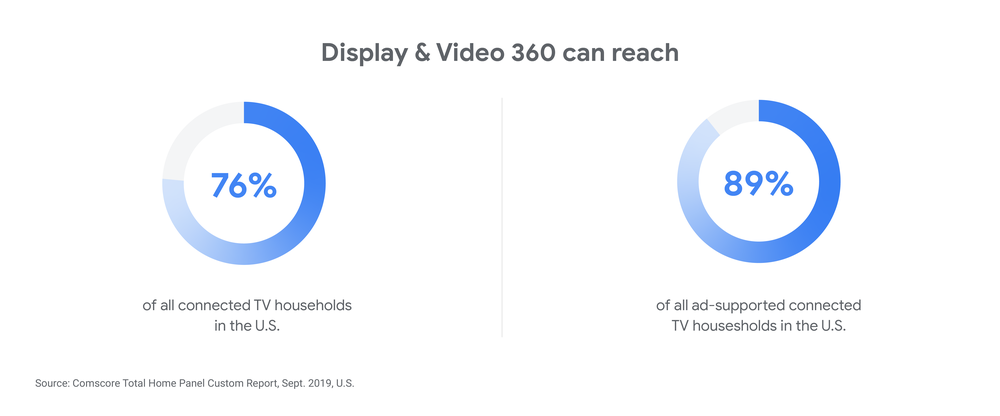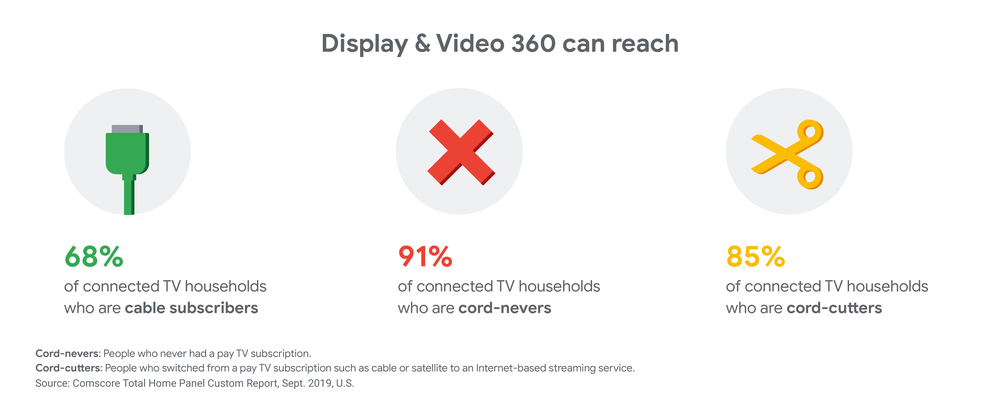Get the reach of TV and the relevance of digital with Display & Video 360
>>> Shared from Original Post The Keyword
Connected TV combines the reach and familiarity of traditional TV with the relevance and measurability of digital. For marketers to get the best of both worlds, we’re investing in connected TV advertising solutions designed to reach households at scale with messages that are relevant to users and respectful of their privacy.
The reach of TV
Brands have historically turned to traditional TV to connect at an emotional level with a wide range of people as they watch premium content. But as the media landscape becomes increasingly fragmented, advertisers have been left searching for new ways to engage with viewers at scale and build their brands. Good news - with more and more premium TV content available via streaming and accessible with programmatic technology, achieving reach through connected TV in a high-quality, brand safe environment has never been easier.
To help marketers quantify this opportunity, we retained Comscore to evaluate the reach of Display & Video 360’s connected TV advertising solutions in the US. Comscore’s analysis found that with Display & Video 360 marketers can now reach 76 percent of all connected TV households in the US and 89 percent of ad-supported connected TV households.1 This accounts for more than half of all US Wi-Fi households and this number is expected to increase as connected TV penetration grows. In addition to YouTube, Display & Video 360 provides access to 9 of the top 10 most watched ad supported connected TV apps from cable and broadcast channels in the US.

Just as connected TVs are becoming mainstream devices in US homes, buying connected TV ads programmatically is also becoming a mainstream way to engage with all sorts of audience groups ranging from cable subscribers to cord-cutters, and from Gen X to more senior viewers. To test this assumption, we looked at the reach of Display & Video 360 across different household types. As it turns out, while Display & Video 360 connected TV ads remain a must-have if you’re after cord-nevers and younger viewers, they are now relevant to your strategy no matter the age and TV subscription status of your core audience.

The relevance and measurability of digital
What makes connected TV advertising especially powerful is its ability to apply best practices from the digital world. For example, frequency management helps you spend money efficiently and avoid ad fatigue with users.
Last year, we announced that Display & Video 360 was supporting the IAB Tech Lab guidelines and using the Identifier for Advertising (IFA) to effectively manage ad frequency for connected TV. IFA is a standardized identifier that can be disabled or reset by the user. Since then, the industry has widely adopted IFA. In fact, last year alone, Display & Video 360 saw an 88 percent increase in connected TV IFA adoption by publishers on our top five video exchange partners.2 Today, to further extend your frequency management capabilities, we’re working with inventory providers to support IFAs at the exchange and publisher levels. For example, we recently integrated with Telaria’s video management platform, enabling you to control frequency in a user-first way on publishers such as Hulu, Pluto TV or Lifetime.
To help you deliver a more pleasant and personalized viewing experience on connected TV, we have also integrated with audience and measurement partners investing in the IFA standard. Display & Video 360 now supports Comscore’s IFA-based audience segments across connected TV devices.
If you want to explore connected TV ads as a way to recreate your TV reach in 2020, Display & Video 360 will help you connect with a large number of streaming households. And to harness the digital capabilities of connected TV advertising, make sure you use IFA to manage how often viewers should see your spot and what is the most appropriate ad message.
1. Source: Comscore Total Home Panel Custom Report, Sept. 2019, U.S.
2. Internal data, IFA coverage for top exchanges, US, Jan 2020
>>> Read the Full Story at The Keyword
